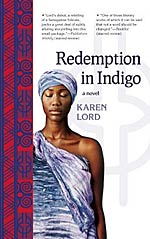
![]() Linguana
Linguana
4/13/2013
![]()
Redemption in Indigo
by Karen Lord
Published by: Small Beer Press, 2010
ISBN: 0043339158
eBook: 200 pages
Standalone
My rating: 7,5/10
First sentence: A rival of mine once complained that my stories begin awkwardly and end untidily.
Paama's husband is a fool and a glutton. Bad enough that he followed her to her parents' home in the village of Makendha—now he's disgraced himself by murdering livestock and stealing corn. When Paama leaves him for good, she attracts the attention of the undying ones—the djombi— who present her with a gift: the Chaos Stick, which allows her to manipulate the subtle forces of the world. Unfortunately, a wrathful djombi with indigo skin believes this power should be his and his alone.
Bursting with humor and rich in fantastic detail, Redemption in Indigo is a clever, contemporary fairy tale that introduces readers to a dynamic new voice in Caribbean literature. Lord's world of spider tricksters and indigo immortals is inspired in part by a Senegalese folk tale—but Paama's adventures are fresh, surprising, and utterly original.
When you start reading Karen Lord's Redemption in Indigo, you will not be able to say just where the story begins. It is narrated in such a way that makes you believe another person is telling you the story, frequently breaking the fourth wall, jumping ahead in time or space, explaining to you that a character might not be all bad, despite what you've seen him do. Redemption in Indigo is almost like a conversation between reader and storyteller.
The first few chapters are a retelling of the Senegalese folktale "Ansige Karamba, the glutton" but Lord decided that the story shouldn't end there. Paama is a magnificent cook, famed throughout the land for her culinary creations. Her husband is a glutton – a match made in heaven, one might think. If it weren't for Ansige's foolishness when it comes to food. He will eat anything, especially if he suspects somebody else so much as looks at his food. And Ansige considers all food his food. When he embarrasses himself and Paama in her own hometown, she decides to leave him, once and for all.
Ansige's escapades in search of more food may be troubling and mortifying for Paama, but they were delightfully funny to read. Karen Lord takes on a fairy tale-esque narrative style, infused with a subtle sense of humor. In this very slim novel, she manages fantastic characterization that rivals many bigger books. She features strong women, several djombi, and to my particular delight – Anansi, the trickster god. And every single one of them is drawn with precision and love for humanity. In all their flaws and ugliness, their beauty and virtues, these characters jump from the page, and take residency in your head for a while.
Lord juxtaposes the magical with the mundane without effort and in case the reader is worried about the physics of it all, the narrator preemts any concerns.
I know your complaint already. You are saying, how do two grown men begin to see talking spiders after only three glasses of spice spirit? My answer to that is twofold. First, you have no idea how strong spice spirit is made in that region. Second, you have no idea how talking animals operate. Do you think they would have survived long if they regularly made themselves known? For that matter, do you think an arachnid with mouthparts is capable of articulating the phrase "I am a pawnbroker" in any known human language? Think! These creatures do not truly talk, nor are they truly animals, but they do encounter human folk, and when they do, they carefully take with them all memory of the meeting. (page 20)
My favorite part was easily Ansige's tribulations but the story really starts when Paama is given the Chaos Stick, a wooden stick holding the power of making the possible probable, and so changing the course of the world, butterfly effect style. This idea really spoke to me and wouldn't have minded seeing more of it. Being the central McGuffin of this tale, the Chaos Stick actually takes a place in the background when we are introduced to the Indigo Lord, a djombi fallen from grace. All I'm going to say is that Karen Lord kept more than one surprise up her sleeve when it came to him.
As you've probably guessed, I absolutely loved the beginning of the book and I enjoyed the rest of it. But at times I felt that it tried to encompass too much for such a limited amount of pages. I can't say that any of the characters wasn't fleshed out enough, even Paama's sister felt real to me (not necessarily likable, but real). I can't complain about the story arc, or Paama's development. But there were side characters whose fate interested me and I never got to read about anymore. The narrative voice, while being utterly enchanting, also kept some distance between me and the characters, making it harder to fully engage with them.
Overall, this was a charming fairytale, retold and continued by a writer well worth following. Karen Lord brings something fresh and new into fantasy, not just because she used an African folktale as inspiration but because she breaks the rules and boundaries of what much of the genre is doing at the moment. And I just love trying new things.
THE GOOD: A funny, light tale with every word in its place, great characters and a wonderful ending.
THE BAD: The characters were somewhat distant, some side characters deserved more screen time. Plotwise a bit forgettable in the end.
THE VERDICT: Recommended for everyone who wants something different than you average epic fantasy. This is a perfect book for a cozy afternoon, spent with trickster gods, objects controlling chaos, creatures with indigo skin, and one woman in the middle of it all.
RATING: 7,5/10 - Very good
http://sffbookreview.wordpress.com/2013/04/06/karen-lord-redemption-in-indigo/